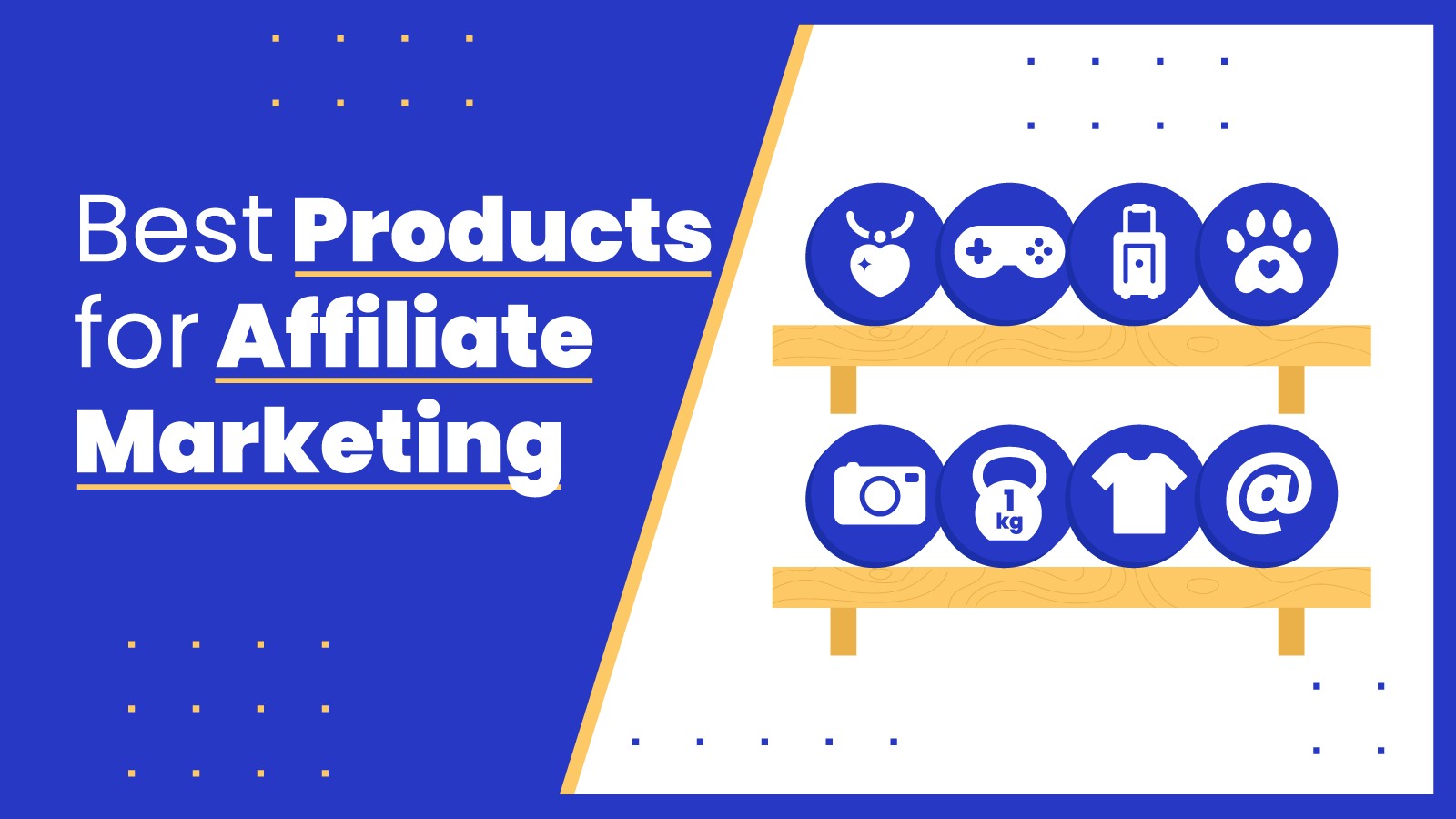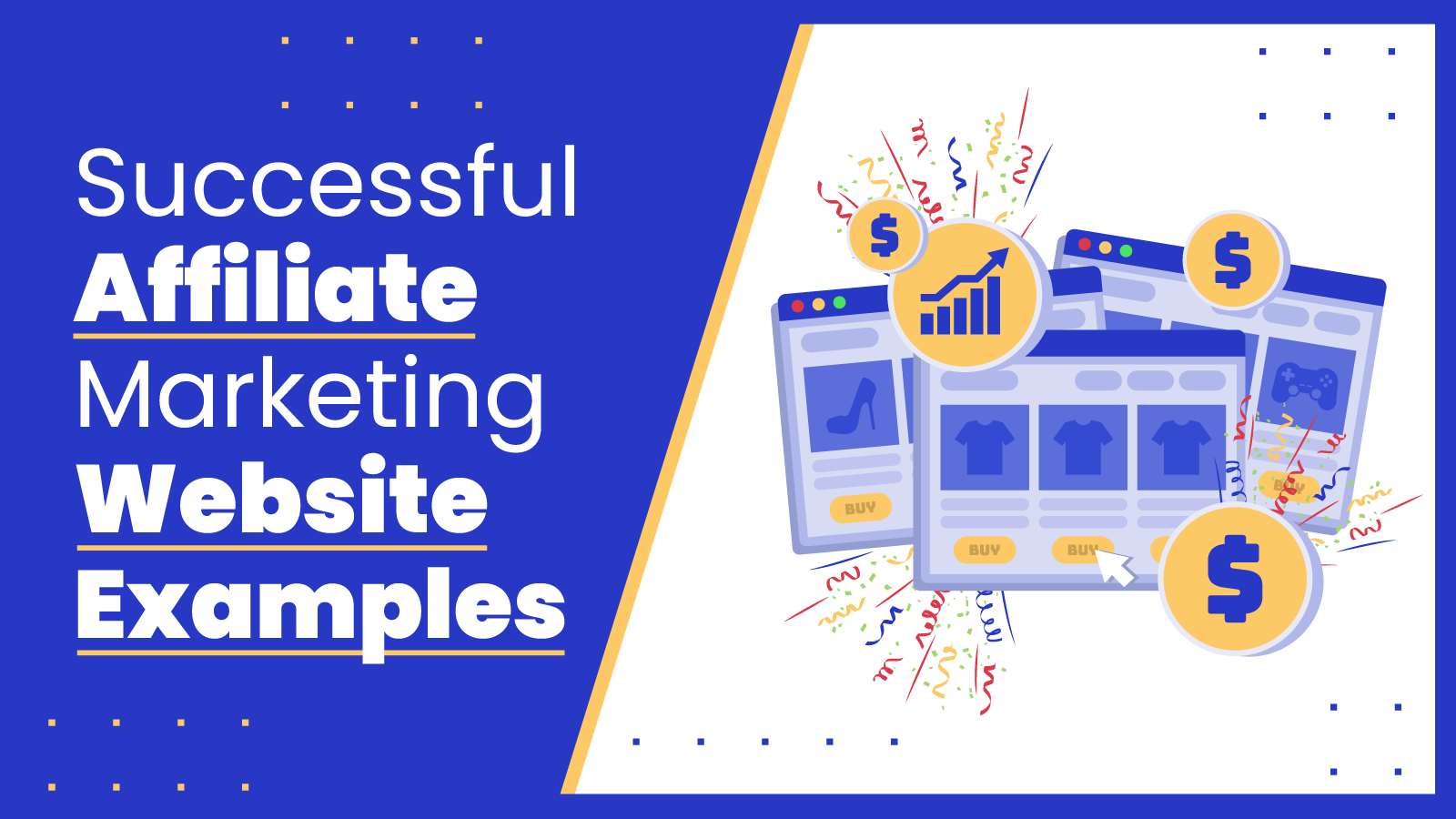Building a website that drives quality traffic is the hardest part of starting an affiliate marketing business.
That’s why you can sell an affiliate website for up to 40x its monthly income.
Which begs the question: “What if you could do affiliate marketing without a website?”
There are some significant drawbacks to that approach:
- Without your own website, it’s hard (or even impossible) to drive traffic from search engines
- You’re not building an asset, which massively reduces the value of your business
- It leaves you highly susceptible to algorithmic updates from social media platforms
- Most affiliate networks require members to own affiliate websites
But, to be clear, you don’t need a website to earn money with affiliate marketing.
If you’re determined to take on the affiliate marketing world without a website, here’s how to do it:
What Do You Need to Become an Affiliate Marketer
Sure, owning an affiliate website makes it easier to become a successful affiliate marketer.
But when you consider the fundamentals of affiliate marketing, none of them explicitly requires a website.
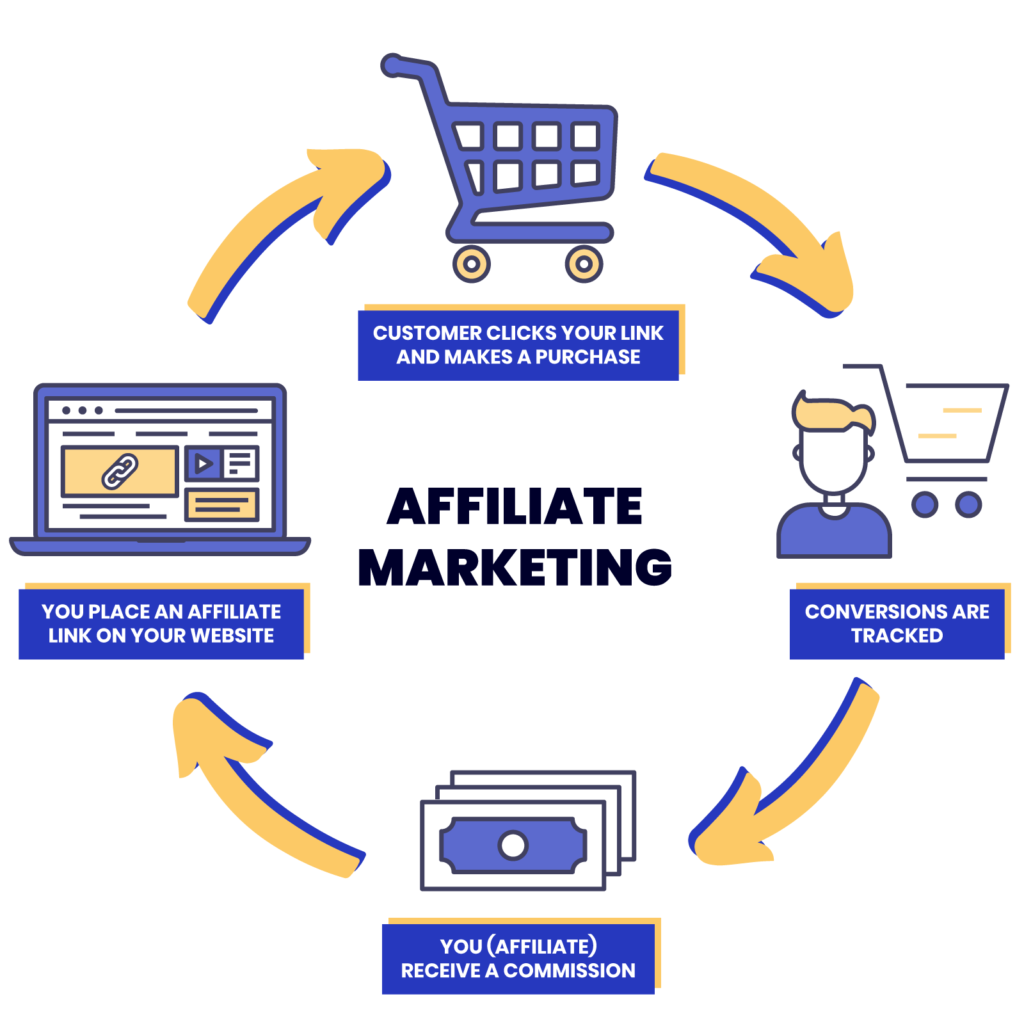
You need three essential “ingredients” to start affiliate marketing:
- An audience: People who are interested in whatever you’re talking about.
- An offer: An affiliate product or service that helps your audience solve a problem or achieve a goal.
- A traffic source: A means of connecting your audience with the offer you’re promoting.
Typically, a website is the hub of all your affiliate marketing activities.
An affiliate might have an email marketing newsletter and accounts on various social media platforms, but they’ll only exist as supplementary traffic sources for the affiliate website.
But there’s no reason you can’t cut out the middleman and promote affiliate links directly from social media sites, email newsletters, or numerous other channels.
Do Affiliate Marketers Need a Landing Page?
There’s no getting away from it:
While you can do affiliate marketing without a website, you’re probably going to need a custom landing page.
Essentially, a landing page is a simple one-page website that helps you sell affiliate products.
Why are landing pages so important?
Because they boost conversions by giving you a place to send traffic from other sources.
Later in this article, we’ll highlight nine channels you can use for affiliate marketing without a website.
But the fact is, none of those channels gives you the freedom to showcase the features and benefits of your affiliate offers.
How Do Landing Pages Help Affiliate Marketers?
With a landing page, you can add a bunch of persuasive copy and engaging imagery explaining why your promoting products or services are a perfect fit for your audience.
Posting an affiliate link to a landing page looks more natural than direct linking from an Instagram bio or YouTube intro.
Or you can use landing pages as a lead capture mechanism.
Adding a lead form to your custom landing page is an effective way to build an email marketing list.
And once you’ve got a few thousand names on your email list, you can send targeted affiliate offers straight to their inbox.
That’s a smart move because email marketing delivers an estimated return of $35 for every $1 invested.
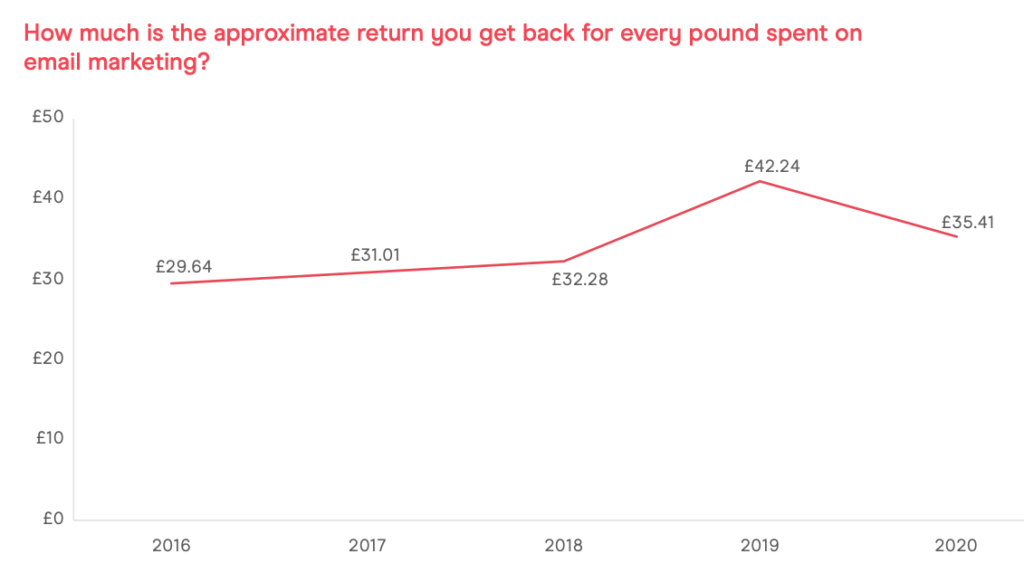
And landing pages offer another important benefit:
They allow you to generate traffic through Google Ads (formerly known as Google AdWords).
You can’t run paid advertising on Google without landing pages, so if ads are part of your affiliate marketing strategy, they’re non-negotiable.
Tools for Building High-Converting Landing Pages
You don’t need coding skills or technical knowledge to build landing pages.
Otherwise, you might as well just create a whole affiliate website. Then you wouldn’t need this article at all.
They’re easy to develop using tools like:
ClickFunnels
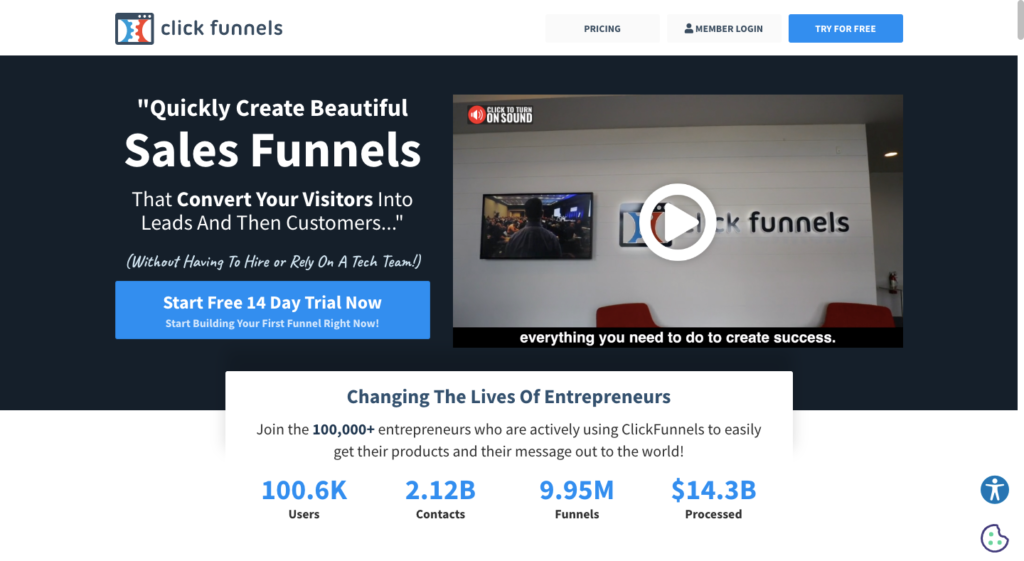
- Pricing: From $97/month for up to 20 sales funnels and 100 landing pages; includes a 14-day free trial
ClickFunnels helps its customers build beautiful pages inside a sales funnel without coding skills.
It offers a simple drag-and-drop editor and all the tools to follow up with visitors even after they leave your page.
It also includes automations for Facebook and email marketing.
Leadpages

- Pricing: From $$37 per month for one website; includes a 14-day free trial
Leadpages is a tool that helps small businesses build websites, landing pages, popups, alert bars, and more.
Its conversion-optimized, mobile-responsive templates make it easy to build and customize a professional-looking landing page in minutes.
Don’t worry if this is your first-ever page build, because Leadpages will predict your page’s performance and identify improvements before you hit “publish.”
MailerLite
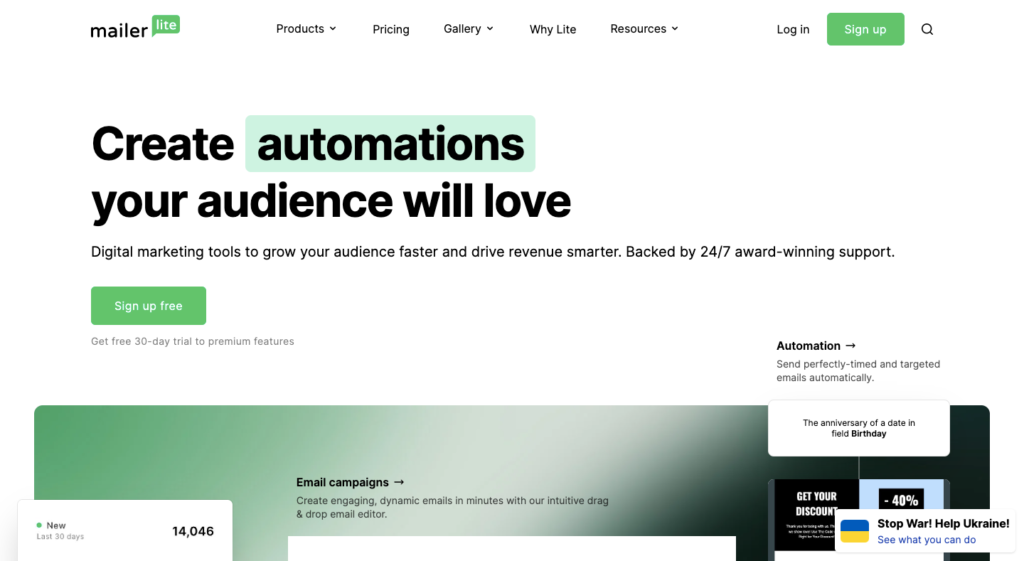
- Pricing: Free for up to 1,000 email subscribers and 10 landing pages
MailerLite is primarily an email marketing platform, but it includes a free landing page builder based around templates and a drag-and-drop editor.
Once again, that means you don’t require any coding skills to use it.
It also offers free hosting and a free custom URL, which helps your page look more trustworthy.
Woorise
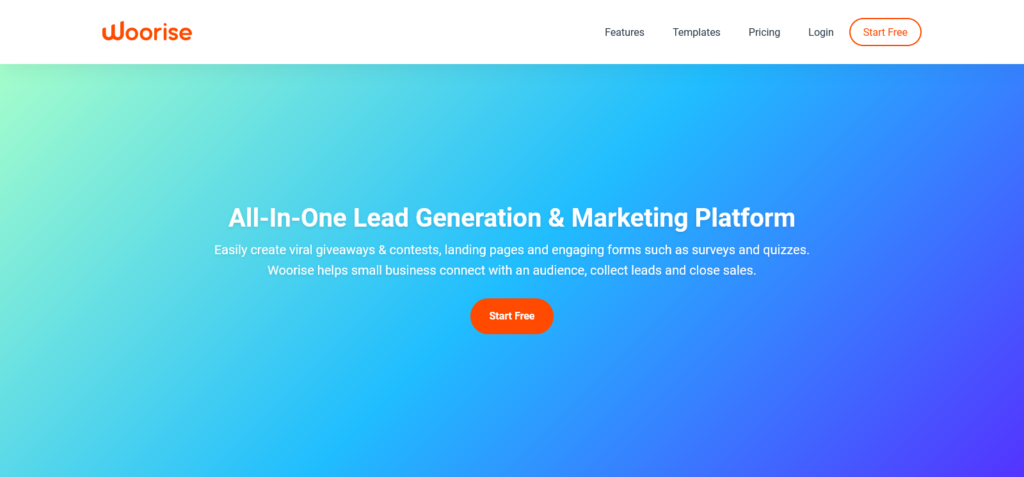
- Pricing: Free for up to 200 landing page “entries” per month
Woorise is a lead generation and marketing platform that offers tools for creating landing pages, data capture forms, competitions, and giveaways.
Users start with a mobile-responsive, conversion-optimized landing page template, which can be customized through Woorise’s simple drag-and-drop builder.
The platform also allows website owners to add popups to any landing page in just a few clicks, helping you guide visitors toward conversion.
9 Ways To Do Affiliate Marketing Without a Website
Now that we’ve got the theory out of the way, let’s look at nine practical tactics for affiliate marketing without a website.
1 Posting On Online Forums & Communities
Online communities and forums (or should that be fora? Curse my lack of Latin) are becoming increasingly popular.
Two of the best-known examples are Quora and Reddit.
Quora has about 300 million monthly active users, while Reddit boasts 50+ million daily active unique users and attracts about 1.7 billion visits per month:
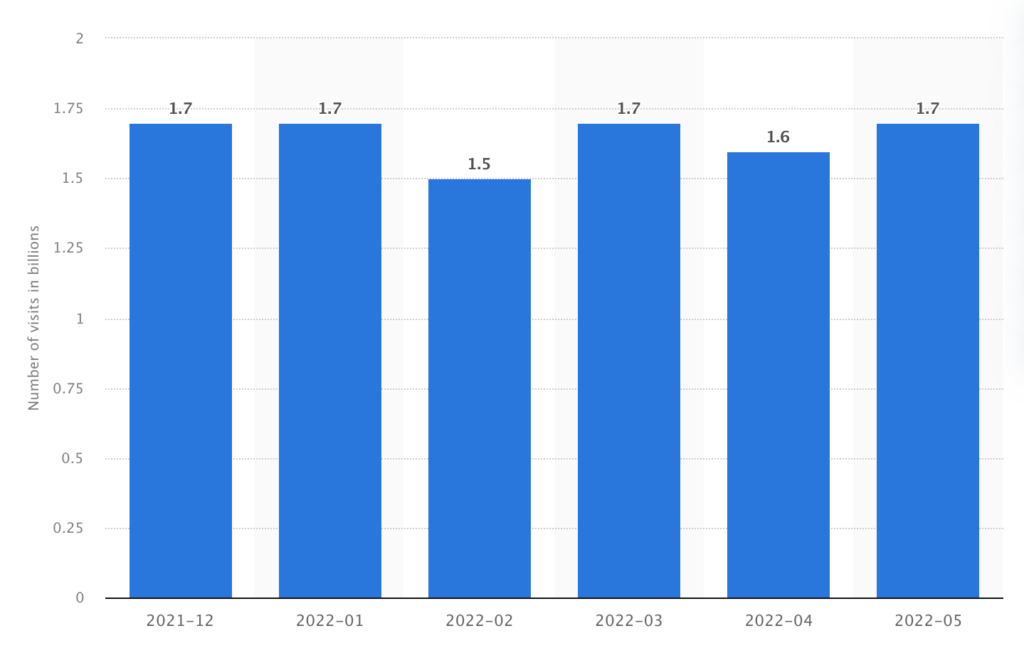
Both platforms are full of engaged users searching for information on niche topics.
Some of those niches are just plain bizarre (like sharing pictures of long furbies or stapling bread to trees).
But others are an absolute goldmine for affiliate marketing, because they’re loaded with commercial intent.
And where there’s commercial intent, there’s an opportunity to earn passive income.
Take a look at this question posted on Quora:

If you were a new affiliate marketer in the pet niche, this would be a slam-dunk opportunity to demonstrate your expertise, recommend a couple of products, and point people toward your landing page.
But online communities aren’t a shortcut to affiliate marketing success.
If you exclusively write spammy posts that only exist for promoting affiliate links, no one’s going to pay attention.
Plus, you’ll get downvoted to oblivion and eventually banned.
As with any piece of content marketing, adding value is the key to gaining traction on sites like Quora and Reddit.
Don’t try to jam a bunch of products down people’s throats.
Instead, provide thoughtful, well-researched answers that help fellow users solve their problems.
Also, take the time to ask your own questions and engage with other responses.
That way, you’ll look like a knowledgeable member who occasionally recommends relevant products and services.
2 Create YouTube Channel
Creating a YouTube channel can be another effective way to start promoting affiliate links.
So much so that we’ve written a whole guide to affiliate marketing on YouTube.
YouTube videos have massive traffic-generating potential.
On mobile devices alone, YouTube reaches more adults during prime time than any cable network.
But you already know what YouTube is.
So how can you use it to make money online through affiliate marketing?
Actually, it’s pretty simple:
Create YouTube videos incorporating affiliate products that appeal to your audience, then post links to those products in the video description.
There are a number of video styles and formats on YouTube. But from an affiliate marketing perspective, you’ll mostly focus on:
- Product reviews: In-depth reviews of a single product.
- Product comparisons: Review-style pieces that pit two or more products against each other.
- How-to guides: Informational content that explains how to solve a specific problem.
- Unboxing videos: Literally just someone opening a package and sharing the experience. People will watch anything!
- Best-of videos: Round-ups of the best products in a specific category or tailored to an occasion (like Christmas gift guides).
Let’s look at an example from the folks at Canadian Prepper, who created a video rounding up their top survival gear picks:
Scroll down to the video description and you’ll see links created through Amazon’s affiliate marketing program, plus other programs like Canadian Preparedness and Premier Body Armor:
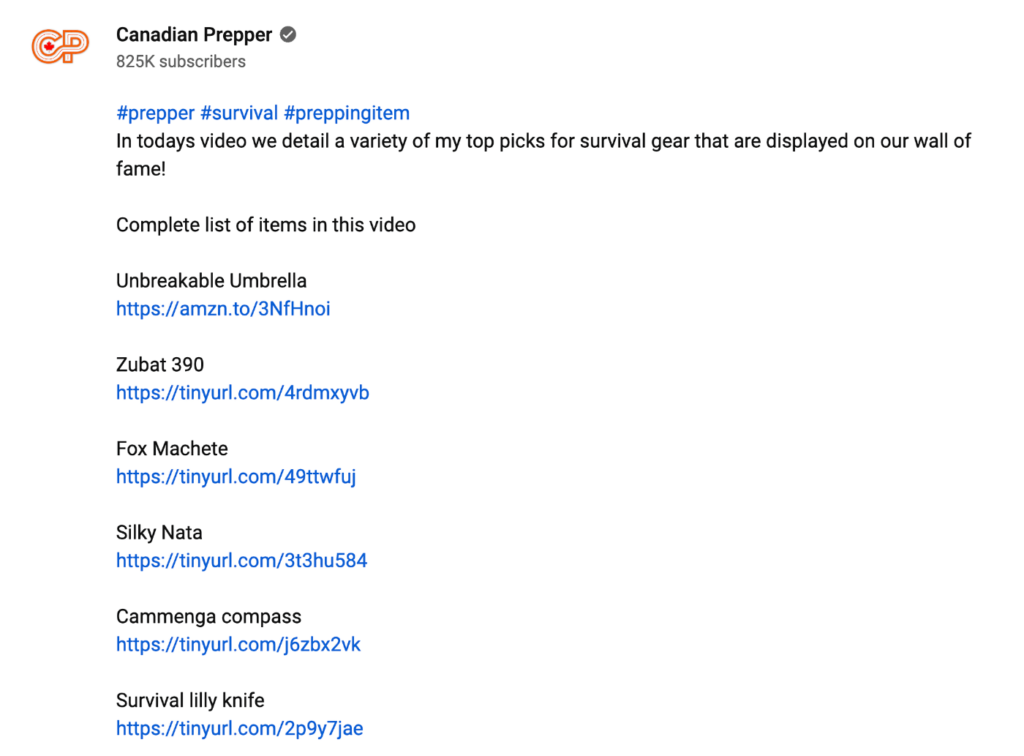
Canadian Prepper has 812,000 YouTube subscribers, and its most popular YouTube videos have millions of views, so it’s easy to imagine how many potential customers they’re reaching.
And the good news is, that this approach can work for pretty much any niche.
3 Use Paid Advertising On Search Engines
If you’re doing affiliate marketing without a website, generating organic traffic from search engines is tough.
For that reason, many website-less affiliate marketers rely on paid ads — specifically search ads — to bring in the numbers.
Also known as pay-per-click (PPC) advertising, paid ads involve bidding on keywords related to the affiliate products you’re promoting.
Google places PPC ads at the top and bottom of the search engine results page and highlights them using the word “Ad.”
That way, searchers know they’re clicking a paid link rather than an organic (i.e. free) one.
PPC ad campaigns are easy to build.
Write engaging ad copy, link to your landing page, and set a budget, then you’re ready to go.
However, there’s a problem with relying on paid traffic:
Many affiliate marketing niches have tight margins.
You might only earn a few bucks per sale.
And remember, only a small proportion of potential customers who click your ads are going to buy.
So you can’t afford to pay large sums for every single click.
Benchmarking data from Wordstream shows that the average cost per click in some niches is $8+.
Unless you’re earning massive commissions at a spectacular conversion rate, that’s unsustainable.
4 Publish on Content Platforms
A content publishing platform is kind of like having your own blog without a website.
Popular examples include Medium and Steemit, but many other platforms are out there.
According to SimilarWeb, Steemit attracts about 3.5 million visitors a month, while Medium brings in around 40 times that number.

So they’re both big platforms with millions of engaged users.
It’s a quick and easy-to-use content publishing platform for affiliate marketing.
Set up a profile, write a blog post, add an affiliate link or two, and you’re good to go.
Just be sure to add an affiliate disclosure explaining you’ll earn a commission from any sales generated through links:
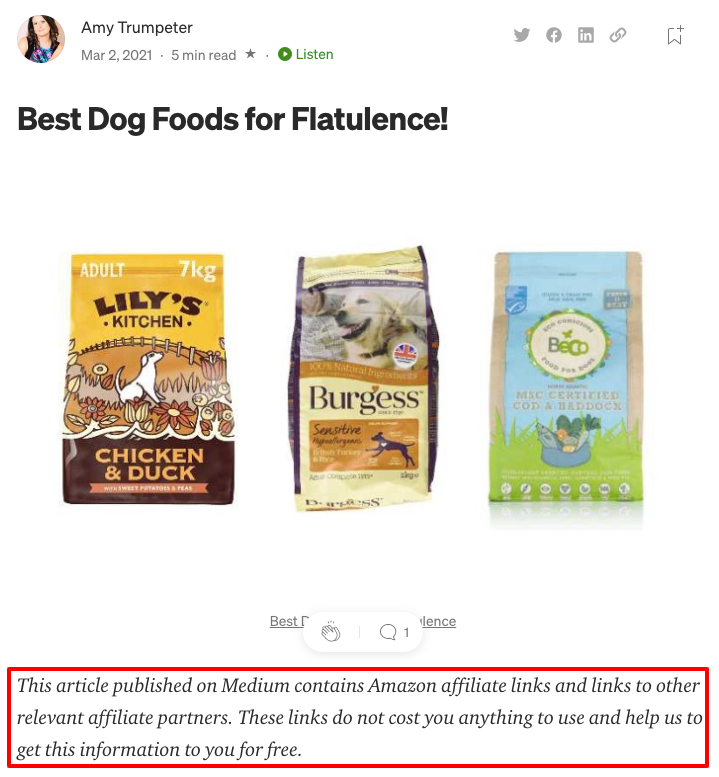
5 Utilize Social Media
Already got a social media to account with a large audience?
Or maybe you’re keen to build a following on one of the big social media platforms?
Either way, it’s possible to convert social media fame into passive income through the magic of affiliate marketing.

Each social media platform has its own complexities, which we explain in our in-depth guides to:
- Affiliate marketing on Facebook
- Affiliate marketing on Instagram
- Affiliate marketing on TikTok
- Affiliate marketing on Twitter
For instance, with Insta and TikTok, you can’t promote affiliate links from social media posts, so you’ll need to link from your bio instead. That makes life a little more complicated.
However, the general idea is the same whether you’re using a Facebook page, a TikTok profile, or other such websites:
Create content that appeals to potential customers in your niche, recommends relevant products, and link to them.
It’s up to you whether you point people toward your landing page or the advertiser’s product page.
6 Take Advantage of Email Marketing
We’ve already mentioned how email offers a sky-high return on investment. In fact, our affiliate marketing stats show that affiliate marketers who use email marketing earn 66.4% more than those who don’t.
It’s also super cheap. You’ll likely need some form of email marketing software, but platforms like Mailchimp offer free plans that are perfect for new affiliate marketers.
That means email is effectively a free traffic source.
But, as with everything in life, there’s a problem:
You need to encourage people to sign up for your email list before you can start sharing tempting affiliate offers.
👉 Read more: How to Build an Email List for Affiliate Marketing
You’ll need a landing page and a compelling offer to do that because no one’s going to hand over their email address without an incentive.
At Authority Hacker, our newsletter “pitch” is simple:
Sign up and get access to our latest insights before anyone else.

That works for us because we already have a vast content library and a strong reputation, but it’s a tougher sell if you’re a new affiliate marketer.
7 Create Ebooks
Ebooks rose to prominence in the world of B2B marketing.
If you’re unfortunate enough to regularly use LinkedIn, you must have seen dozens of ads urging you to download their latest ebook:
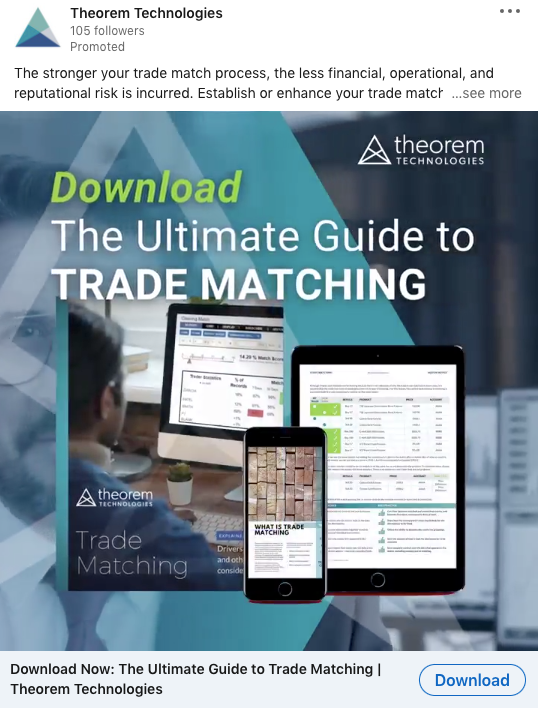
It’s easy to see why they’re so popular.
Ebooks are a prime example of thought leadership content marketing. And research shows that most business decision-makers spend at least one hour a week reading thought leadership content.
So ebooks are an obvious tactic if you’re a B2B affiliate marketer.
However, they can also work in the B2C space. You just need to find an appropriate topic.
As an added bonus, ebooks can help you build an email list.
Add a lead capture form to your landing page and offer your shiny, new ebook in exchange for a name and email address.
To use ebooks in your affiliate marketing strategy, you’ll need to create a piece of in-depth content — typically 3,000+ words — and package it as a PDF.
Ideally, your ebook will:
- Speak to a crucial audience pain point
- Provide a solution
- Recommend relevant affiliate products
Once you’ve done all that, you’ve still got to find a way to promote your ebook.
So you’ll have to combine ebooks with at least one of the other tactics in this article.
For instance, try seeding it in online communities or sharing it on social media.
8 Record Podcasts
Podcasts aren’t the most obvious way to do affiliate marketing without a website.
They’re an audio medium, which isn’t ideal for promoting affiliate links.
What are you going to do? Spell out your referral link character by character.
But podcasts are too popular to ignore.
A 2022 survey found that three-fifths of US consumers listen to audio podcasts, up from 57% in 2021.
So how can you get in on the act?
The easiest solution is to discuss affiliate products on a podcast and include affiliate links in the show notes.
Just remember to tell listeners where to find those links. Otherwise, no one’s going to see them, let alone click them.
9 Solo Ads
Never heard of solo ads?
They’re a relic from the early days of affiliate marketing when everyone did it without a website.
But they can still work in the right circumstances.
Solo ads are a type of email-based advertising that involves paying for access to someone else’s marketing list. Prices are agreed based on:
- How many subscribers will see your message
- How many clicks do you want to generate
Typically, the whole message will be dedicated to your affiliate offer, helping you reach a large, engaged audience without the hassle of building your own email list.
Or at least that’s the idea.
In practice, there are some major pitfalls to solo ads.
There’s no way to verify the quality of the list you’re paying to access, so it could be full of scraped email addresses or bots.
In which case, you’ve wasted a bunch of money.
However, platforms like Udimi claim to make the solo ads space more “legit” by promising protection against fraud, spam, and timewasters.
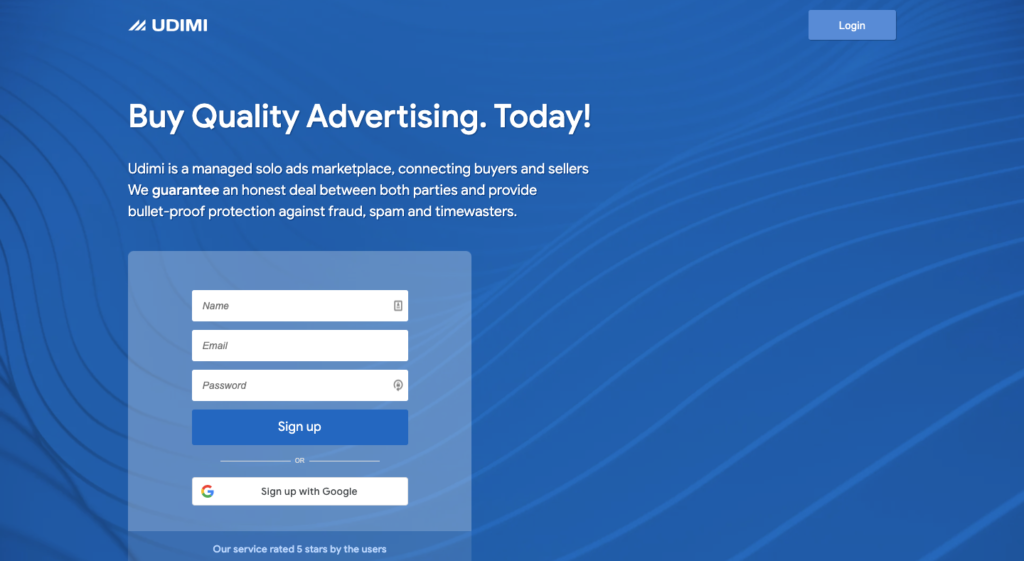
Even so, we’d treat solo ads with caution.
Tips for Affiliate Marketing Without a Website
This article has enough tactics to help you start affiliate marketing without a website immediately.
But before you dive in, we strongly advise checking out these top affiliate marketing tips:
Narrow Down Your Niche
Choosing a niche is the first step to becoming an affiliate marketer.
If your niche is too broad, you’ll be competing with massive publishers, which will massively affect the amount of quality traffic you can generate.
But if you niche down too far, you’ll limit the size of your audience.
Try to find a sub-niche within a much wider niche.
For instance, focus on dog food or pet insurance rather than becoming a pet affiliate,
If you need a little inspiration, check out our hand-picked list of the 140+ best niches for affiliate marketing.
Find Affiliate Programs That Don’t Require a Website
If an affiliate program demands you have your own website, there’s nothing you can do but look elsewhere.
To save you wasting time applying for programs that will never accept you, here’s a list of major affiliate networks and programs that are happy to work with website-less affiliate marketers:
ClickBank
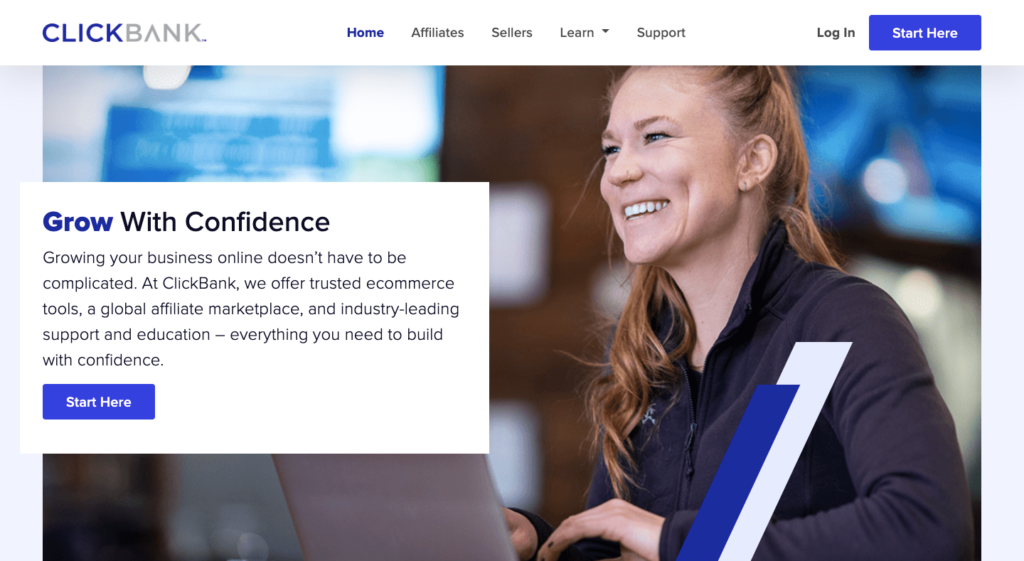
ClickBank is an affiliate network specializing in revenue share and CPA affiliate programs in the eCommerce space.
It’s home to 100,000+ sellers and pays up to $150 per sale commission.
For more information, check out our ClickBank review.
Amazon Associates

Amazon Associates is probably the world’s biggest and most successful affiliate program.
The eCommerce marketplace sells every product under the sun, is highly trusted by consumers, and achieves superb conversion rates.
That means it’s the first port of call for many first-time affiliate marketers.
Amazon’s commissions aren’t the best, but it’s still a solid source for making money with affiliate marketing.
For more information, check out our Amazon Associates review.
ShareASale

ShareASale is another affiliate network that’s happy to work with you even if you don’t have a website.
It works with 21,000+ brands across 39 consumer categories, including big names like Allbirds, Etsy, and Reebok.
The network paid out $1.3 billion in commissions last year, so it’s a reliable earner for many affiliates.
For more information, check out our ShareASale review.
Rakuten Advertising
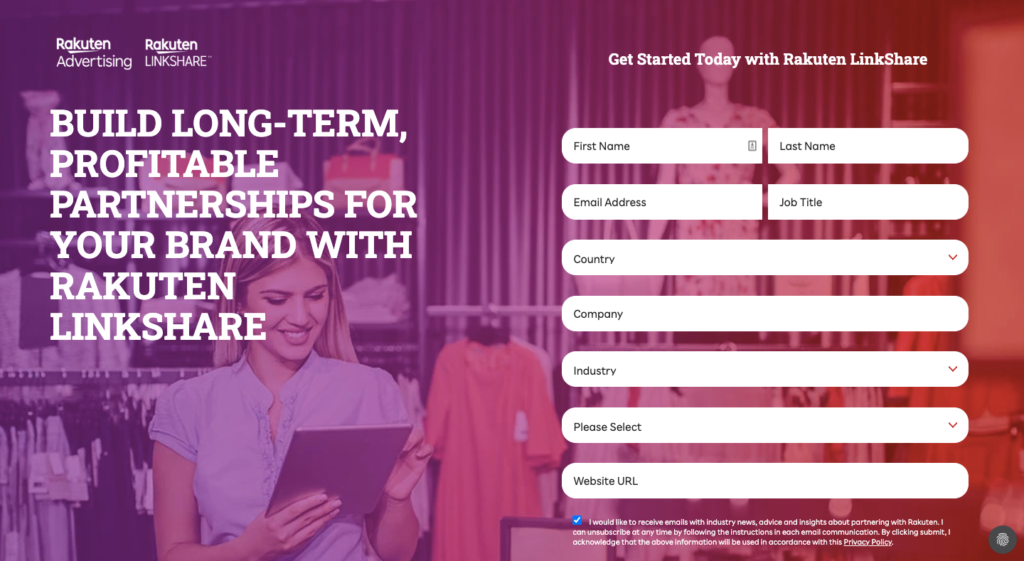
Rakuten Advertising is an affiliate network operated by Japanese ecommerce and advertising giant Rakuten.
While you don’t need your own website to join, Rakuten warns: “Without a website, it will be difficult for advertisers to confirm that you are right for their program and you may find that many are reluctant to accept your application to join their affiliate programs.”
For more information, check out our Rakuten Advertising review.
Conclusion
We think this article makes two things clear:
- It’s totally possible to do affiliate marketing without a website…
- …but if you don’t have a website, it’s harder to become a successful affiliate marketer.
With no website, you’ll struggle to generate organic traffic.
You won’t be building a sellable asset.
And you’ll be shut out of some of the best affiliate networks and programs.
So don’t be intimidated; bite the bullet and build a website!
Before you start, sign up for our free training, where we’ll reveal the seven secrets that make new websites 83% more successful.
